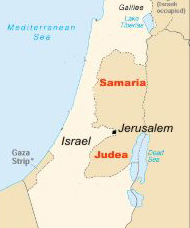Many pro-Palestine activists and members of the international community falsely have claimed that Israel has violated the Fourth Geneva Convention. For example, a UN Human Rights Council panel has declared that Israel building Jewish communities in Judea and Samaria violates the Fourth Geneva Convention. Christine Chanet, the French judge who headed this U.N. inquiry, asserted, “To transfer its own population into an occupied territory is prohibited because it is an obstacle to the exercise of the right to self-determination.” Yet any careful examination of international law would establish that Judea and Samaria, as well as East Jerusalem, are not occupied territories and that the Geneva Convention spoke of forced transfers, such as what the Nazis did, not the voluntary transfers that Israel engages in.
Firstly, Article 49 of the Geneva Convention was drafted following the Second World War, during which time millions of people were deported, displaced and massacred. In the case of the Jews and Gypsies, outright genocide was committed. Article 49 of the Geneva Convention was created in order to prevent a repeat of what happened in Europe under the malaise aggression of Nazism. For this reason, Article 49 of the Geneva Convention states, “The Occupying Power shall not deport or transfer parts of its own civilian population into the territory it occupies.”
The International Commission of the Red Cross clarified this article in 1958 by asserting, “It is intended to prevent a practice adopted during the Second World War by certain Powers, which transferred portions of their own population to occupied territory for political and racial reasons or in order, as they claimed, to colonize those territories. Such transfers worsened the economic situation of the native population and endangered their separate existence as a race.” This establishes the point that Article 49 of the Geneva Convention refers to forced transfers of population that result in endangering a conquered nations’ existence, not voluntary settlement to open areas, even for cases when an occupation does indeed take place.

Yet, there is a strong legal case to be made that the term occupation does not even apply to Judea and Samaria, as well as East Jerusalem. Article 2 of the Geneva Convention has made clear that the Fourth Geneva Convention only applies to two or more high contradicting parties, which is not the case at hand since the international community never recognized Jordan’s annexation of Judea and Samaria. Further, Egypt never bothered to annex Gaza and no Palestinian Arab state ever existed throughout human history. However, according to the San Remo Resolution of April 25, 1920 and the Mandate for Palestine of July 24, 1922, Judea and Samaria, East Jerusalem, and Gaza were all supposed to be part of a Jewish state. These agreements are still relevant, since Article 80 of the UN Charter states that all mandates of the League of Nations are still valid.
Some people falsely believe that the Palestine Mandate was terminated in 1947, but this is not correct. According to Professor Eugene Rostow, former dean of Yale Law School, “A trust never terminates when a trustee dies, resigns, embezzles the trust property, or is dismissed. The authority responsible for the trust appoints a new trustee, or otherwise arranges for the fulfillment of its purpose.” Thus, while the Palestine Mandate ceased to exist in Israel and Jordan when Israel and the Hashemite Kingdom obtained independence, Professor Rostow claims “its rules apply still to the West Bank and the Gaza Strip, which have not yet been allocated either to Israel or to Jordan or become an independent state.” He claims that legally speaking, the Armistice Lines of 1949 represent nothing more than the positions the contending armies finished at the conclusion of Israel’s War of Independence.

Leading international law expert Julius Stone concurred. He asserted that Article 49 only relates to the invasion of sovereign states, a title the Palestinians never possessed. Stone also argued that the history behind the drafting of Article 49 of the Geneva Convention needs to be taken into account, especially considering how drastically different Israel’s situation in Judea and Samaria is to what existed in Europe under Nazism. He furthermore asserted, “No serious dilution (much less extinction) of native populations exists, rather a dramatic improvement in the economic situation of the local Palestinian inhabitants since 1967 has occurred.”
Since the end of World War II, no territorial dispute in the world has been defined as occupied territories, except in Israel’s case. According to Eli Hertz, in virtually every other disagreement concerning borders and territories, the most common terms applied are territorial disputes and contested borders. This is even the case for the places like the Western Sahara, Northern Cyprus, and Nagorno-Karabakh. Furthermore, given the legal status of Palestine under the British Mandate, as a state to be established for the Jewish people, Israel also has stronger grounds to argue based on international law that these territories are within her national borders than any other state within the region.
By Rachel Avraham

No comments:
Post a Comment